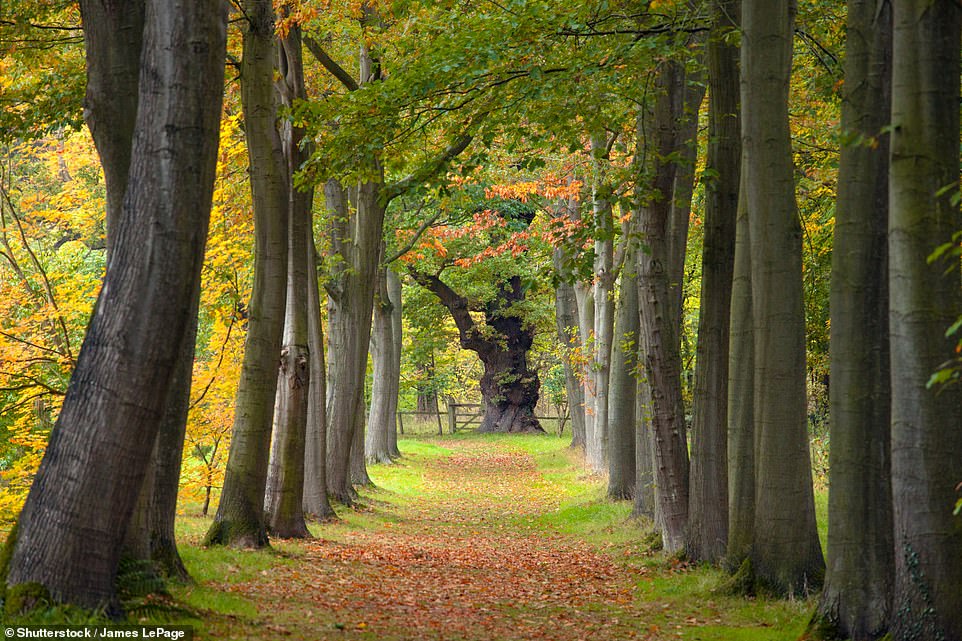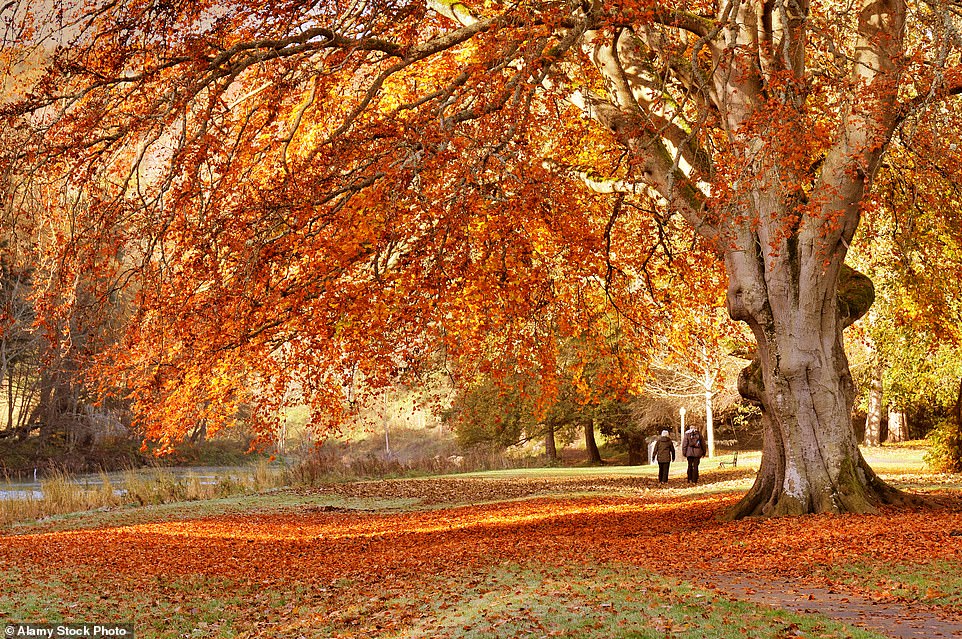Saffron yellow, deep raspberry, flaming orange – who says gardens only blaze with colour in the summer?
As the days grow cooler and flowers and shrubs begin to fade, trees step in – instead of herbaceous borders, it is maple, acers, ash and oak which illuminate the countryside. Pathways become carpets of gold and auburn, on windier days leaves fall like giant confetti and arboretums take over from gardens for weekend walks and family days out.
Aboretum – the term for a collection of trees – is a concept that dates back to the Egyptians, who transplanted groups of foreign trees together to create exotic collections for the Pharaohs. But it was the Victorians who coined the term, at a time when plant and tree collecting – with many species brought back from abroad – was something of a national obsession.

The spectacular Acer Glade at Westonbirt near Bath, which is the country’s best-known arboretum
The first public arboretum opened in Derby in 1840, originally created as a pleasure ground for the city’s workforce. Today Derby Arboretum still has some of its original species, including the American red oak and Indian bean tree.
In spite of their beauty and history, arboretums are often overlooked as places to visit, but in the autumn months there is nowhere better to appreciate the diversity of trees and their richly coloured foliage.
Did you know that most leaves contains reds, yellows and oranges all year round, but the colours are masked by green chlorophyll? But once the days grow shorter, the production of chlorophyll slows down, eventually stopping entirely, allowing the leaves to reveal their vibrant hues.
Few trees can rival the Japanese Maple for it’s eye-popping autumn colours. Also known as acers, they explode in shades of raspberry and saffron as the chlorophyll dies away. One of the finest collections of maples is at Batsford Arboretum (batsarb.co.uk) in Gloucestershire, surrounded by more than 2,800 other tree specimens. Batsford is a brilliant family option, with a play area and kids’ trail, plus the Cotswold Archery and Falconry Centre next door.
The Horse & Groom (horseandgroomcotswolds.co.uk) is a classic Cotswolds inn, just a stone’s throw away.
The country’s best-known arboretum is Westonbirt (forestryengland.uk), near Bath, home to five National Tree Collections and more than 16,000 different specimens, including maples and acers. A 900ft-high treetop walkway winds through the trees, giving a bird’s-eye perspective, while back on ground level there’s a Gruffalo-spotters trail that younger children will adore, as well as family-friendly cycle routes.

Wild thing: Westonbirt has a Gruffalo-spotters trail that younger children will adore, as well as family-friendly cycle routes
Calcot Manor (calcot.co) in nearby Tetbury is a great place to stay if you do have family in tow, combining luxury with a warm, relaxed welcome.
Further west, Stone Lane Gardens Arboretum (stonelanegardens.com) was created in 1971 on the edge of the Dartmoor National Park by the famous botanist Kenneth Ashburner, who planted many of the trees from seed.
Every year, the five acres of trees form a backdrop to an exhibition of new, original sculptural pieces by West Country artists who compete to win the Ashburner prize. The exhibition runs until the end of October, with the pools, streams and tree groves providing a diverse setting for the artworks.

Batsford Arboretum is home to one of the finest collections of Japanese maples – as well as 2,800 other tree specimens
Check in to the Oxenham Arms (theoxenhamarms.com), a historic inn dating back more than 800 years, with walks straight out on to Dartmoor.
Harcourt (obga.ox.ac.uk), which lays claims to being the UK’s oldest arboretum, was created in 1621 as part of Oxford University’s Botanic Garden, and within its 130 acres the world’s rarest and most endangered trees can be found.
In autumn, the Acer Glade explodes in vivid reds and golds, the bracken in the Bluebell Wood blazes warm copper, and the Lime Wood leaves create a carpet of butter-yellow foliage. The arboretum is also home to Dawn Redwoods, which glow brick-red in autumn, towering over the other trees.
The Voco Oxford Thames (ihg.com) is a lovely riverside hotel just a five-minute drive from Harcourt.
One of Worcestershire’s under-the-radar gems, Bodenham Arboretum (bodenhamarboretum.co.uk) stretches across 134 acres, freckled with pools and lakes that offer up crystal-clear reflections of the rare and ornamental trees that surround them.

Remarkable: Few arboretums can match Thorp Perrow in North Yorkshire for its number of ‘champion trees’
Bodenham has more than 3,000 species of trees and shrubs, including sherbert-hued acers, towering North American Oaks and alders, blazing yellow and russet through September and October.
On sunny autumn afternoons, the pre-bookable Afternoon Tea Picnics are a wonderful way to soak up the spectacular landscapes.
Pair it with a visit to nearby Arley Arboretum (arleyarboretum.co.uk), originally laid out in the 1800s, along the banks of the River Severn. Highlights include the spectacular laburnum arch, stretching for 200ft, the magnificent Italian garden and the collection of acers.
Few arboretums can match Thorp Perrow (thorpperrow.com) in North Yorkshire for its number of ‘champion trees’ – exceptionally large, historic or remarkable specimens – which include some of the tallest and widest in the country.
Kids will love the wooden adventure play area, trails through the woods and the chance to meet exotic birds and animals in the Birds of Prey and Mammal Centre, while the tea-room is the perfect spot to refuel, with all ingredients on the menu sourced from local producers.
Splash out on a stay at the nearby Swinton Estate (swintonestate.com), which offers a huge range of outdoor activities alongside luxurious rooms and a cookery school.
Further north, Northumberland’s Howick Arboretum (howickhallgardens.com) is known as the United Nations of trees, with more than 12,500 specimens divided into six geographical regions. In autumn, the East Asian and North American sections light up with colours from the clusters of acers and maples.

Northumberland’s Howick Arboretum is known as the United Nations of trees, with more than 12,500 specimens divided into six geographical regions
The Old Rectory (oldrectoryhowick.co.uk) is a charming B&B close to the gardens and just 400 yards from the sea.
Just over the border, Dawyck Botanic Garden and Arboretum (rbge.org.uk) is home to one of the finest collections of trees in Britain, with some planted in the 17th Century. The cooler temperatures allow trees to live for longer, with some of the conifers dating back to the 1680s. Autumn highlights include the giant Sierra redwood, the Japanese katsura or ‘candyfloss tree’ (so-called because of the sweet scent it emits in autumn) and the Golden Birch, but much of the 65 acre garden is lit up with colour.
Combine hearty walks with pampering spa treatments at nearby Stobo Castle (stobocastle.co.uk), Scotland’s only destination spa hotel.
Out of all the country’s arboretums, none is as moving as the National Memorial Arboretum (thenma.org.uk) in Staffordshire, which celebrates its 20th anniversary this year. Created as an evolving woodland landscape with an impressive 25,000 trees, the park is home to 400 individual memorials to those who have served their country, from overseas regiments to constabularies and war widows.
There’s a wonderful sense of tranquillity, with paths linking the memorials – some of which are tucked away in wooden glades. It’s family-friendly too, with two play areas, a picnic ground and the Stick Man Trail – guaranteed to keep little ones happy.

Red stars: Dawyck Botanic Garden and Arboretum, on the Scottish Borders, has trees planted in the 17th Century
Source link : https://www.dailymail.co.uk/travel/escape/article-10004055/Autumn-activities-Discover-stunning-colours-display-British-arboretums.html












